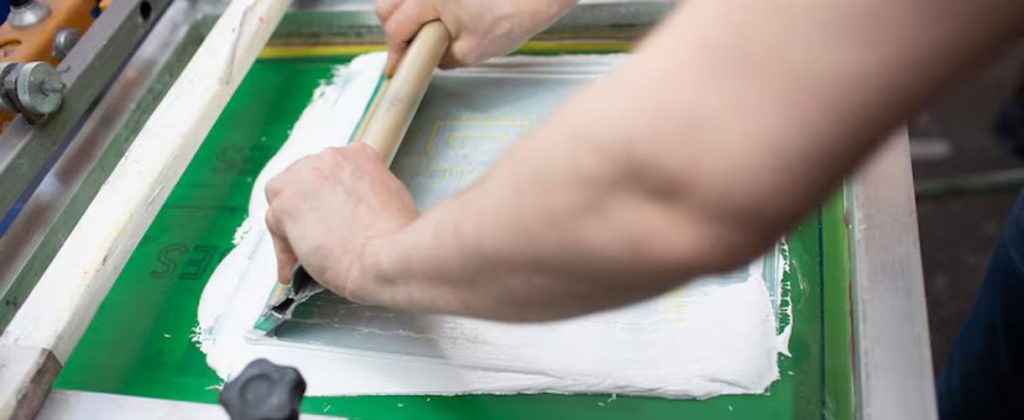Picking the right way to put your design on a shirt can feel confusing. You’re probably thinking: Should I choose embroidery or screen printing? It’s important to figure this out so your shirts look great, last long, and fit your budget.
Go with embroidery if you want a classic, long-lasting, textured look on mid- to heavy-weight fabrics. If you need big, bold graphics on lighter shirts or want to save money for large orders, go with screen printing.
In this article, I’ll break down how each method works, what they cost, and which one to pick for your project. Plus, I’ll share pro tips and a handy FAQ at the end.
How Embroidery and Screen Printing Work
- Embroidery
Embroidery uses a digital sewing machine that stitches threads directly into the fabric. The machine builds up the design one color at a time. It creates a raised, textured look that stands out and lasts a long time.
- Screen Printing
Screen printing pushes ink through a mesh stencil (a “screen”) onto the shirt. Each color has its own screen. The ink sinks into the fabric and dries flat, creating bright, smooth designs.
Quick Tip: Metallic or glow-in-the-dark ink? That’s only possible with screen printing!
Key Differences at A Glance
| Feature | Embroidery | Screen Printing |
| Setup cost | Higher (digitizing + thread setup) | Lower for simple art; rises with colors |
| Best order size | Small to medium | Medium to very large |
| Feel on fabric | Raised thread | Smooth ink |
| Color limit | ~15 per design | Practically unlimited |
| Ideal garments | Polos, jackets, caps | T-shirts, totes, light hoodies |
Info: Ask your decorator for a stitch-count quote. More stitches mean more machine time, which bumps the price.
Cost Considerations
Screen printing is cheaper for big orders because setup fees are spread out. For example, 500 shirts with screen printing might cost half as much as embroidery.
Embroidery is great for smaller runs since the digitizing cost stays the same whether you order 5 or 500 pieces.
Durability and Care
Embroidery can outlast the shirt itself! Threads stay strong, even with lots of washing.
Screen prints look great, but heavy detergents and hot dryers can crack the ink over time. Washing inside out helps.
Danger: Avoid bleach — it damages both thread and ink. Use mild detergent.
Design Flexibility
- Embroidery shines for:
- Small logos and simple graphics
- Left chest designs on polos and jackets
- Text that needs a classic, professional look
- Screen printing shines for:
- Large back or front prints
- Bright, colorful art and photos
- Affordable event tees, sports gear, and band merch
Quick Tip: Thin tees can pucker with embroidery, so use it on thicker garments like polos and hoodies.
Final Checks Before Ordering
- Fabric weight: Embroidery can weigh down thin shirts.
- Order size: Big orders? Screen printing saves more money.
- Design complexity: Many colors on a small run? Embroidery is simpler. Big, bright art on a huge run? Screen printing rules.
When to Pick Embroidery?
Choose embroidery for a timeless, textured mark on polos, jackets, and beanies. It’s perfect for work uniforms and premium merch — strong and sharp!
When to Pick Screen Printing
Screen printing is the best choice for large, bright designs on event shirts, team gear, and promotional merch. It scales well and keeps costs low for big batches.
Conclusion
Embroidery adds a raised, tough look for small logos on thicker garments. Screen printing is best for big, bold designs on lighter fabrics and larger runs. Match your choice to your design, order size, and garment type, and you’ll get pro-level results!
FAQs
Why does screen printing cost less for big orders?
Each color needs one screen, but once setup is done, printing hundreds of shirts is quick — that drops the price fast.
Can I combine embroidery and screen printing on the same item?
Yes! Many brands do a small embroidered logo on the chest and screen-printed artwork on the back or sleeves.
Will embroidered patches feel itchy inside the shirt?
No worries! A soft backing is added to stop the thread from rubbing. If you’re worried, ask your decorator for extra backing.
How many colors can I use with embroidery?
Most machines hold 15 thread colors at once, so staying under that limit avoids extra steps and extra costs.


